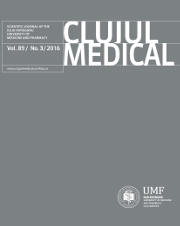Antibacterial coating on biocomposites for cranio-facial reconstruction
DOI:
https://doi.org/10.15386/cjmed-599Keywords:
bacterial adhesion, anti-bacterial agents, cranial implantationAbstract
Background and aims. Despite the fact that implants are sterilized, antiseptic techniques are applied and systemic antibiotics are routinely administered prior to and after craniofacial surgery, infection rates between 3% and 40% are still reported for alloplastic implants, urging for implant removal. The present study focuses on the development of a fiber-reinforced composite (FRC) implant for craniofacial reconstruction with antimicrobial properties.
Methods. A new fiber-reinforced composite coated with gentamicin was developed and tested for bacterial adherence and antibacterial efficiency, using two of the most involved bacterial strains in the postoperative infections: Staphylococcus aureus and Pseudomonas aeruginosa.
Results. Bacteria were efficiently inactivated in direct contact with gentamicin coatings (p<0.05). The inhibition zone for Staphylococcus aureus ranged from 17.21 mm to 20.13 mm and for Pseudomonas aeruginosa ranged from 12.93 mm to 15.33 mm. Although no significant statistical results were found for bacterial adhesion and gentamicin concentration, (Staphylococcus aureus: β= -0.974; p=0.144>0.05 and Pseudomonas aeruginosa: β = -0.921; p=0.255>0.05), a negative relation was observed, indicating the reversed relation between the antibiotic dosage and the bacterial adherence.
Conclusion. The results of the two applied microbiological protocols used in the study suggested that gentamicin eluting coating inhibited not only the bacterial growth, but also led to a lower initial bacterial adhesion to the surface of the implant. Thus, antibiotic coating of craniofacial implants may reduce the infection rate related to reconstructive surgery.
Downloads
Additional Files
Published
How to Cite
Issue
Section
License
The authors are required to transfer the copyright of the published paper to the journal. This is done by agreeing to sign the Copyright Assignment Form. Whenever the case, authors are also required to send permissions to reproduce material (such as illustrations) from the copyright holder.

The papers published in the journal are licensed under a Creative Commons Attribution-NonCommercial-NoDerivatives 4.0 International License.

